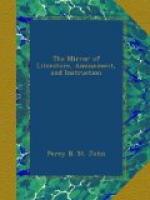TEMPLE AT ABURY.
(To the Editor of the Mirror.)
There is an inconsistency in the account of Abury in No. 341, perhaps overlooked by yourself.
I would ask, how could that arrangement of the fabric, so fancifully and ingeniously described by Stukely, be intended to represent the Trinity, when the place was confessedly in existence long anterior to Christianity? nor is there any thing in the old Druidical or Bardic tenets that can be twisted to any such idea.
This Abury, with Silbury, is supposed to be the Cludair Cyfrangon, or Heaped Mound of Congregations, mentioned in the Triads, the building of which is recorded as “one of the three mighty achievements of the Isle of Britain;” and here were held the general assemblies of the Britons on religious occasions, and not at Stonehenge, as is generally supposed. This last place is decidedly more modern than the pile at Abury; the Welsh call it Gwaith Emrys, (the work of Emrys,) and it ranks as another of the mighty achievements of the Isle of Britain, the third being “the raising of the Stone of Keti,” supposed to be the “Maen Ceti” at Gwyr, in Glamorganshire.
The presumption that Stonehenge is more modern than Abury is founded upon the fact that Stonehenge exhibits marks of the chisel in different parts, while the former does not. The ancient British documents give us the founder of the latter, namely, Emrys, or Ambrosius, while we are left in ignorance as to who raised the pile of Cyfrangon.
Nor was Stonehenge ever of such magnitude as Abury, the diameter of the former being 99 feet, whilst the latter was 1,400; the largest stones of the former weigh 30 tons, but the latter weigh 100 tons!
Gwaith Emrys was possibly more for political than religious assemblies. Here was held the meeting of the Britons and Saxons, when the Plot of the Long Knives (Twyll y Cyllyll Hirion) was consummated, and the flower of the British chiefs treacherously destroyed by their pretended friends.
Different authors have strenuously contended for giving the honour of supremacy to either of these places over both Britain and Gaul, in the days of Druidism; but Rowlands has industriously placed its chief seat in Anglesey.
LEATHART.
* * * * *
TRANSLATED EPITAPH.
(To the Editor of the Mirror.)
Quod fuit esse quod est, quod non fuit
esse quod esse,
Esse quod est non esse, quod est non,
erit esse.
As a translation of this curious epitaph (in Lavenham churchyard) which is formed out of two Latin words, has been requested from some of your readers, I send the following:—
What John Giles has been
Is what he is, (a bachelor.)
What he has not been,
Is what he is, (a corpse.)
To be what he is
Is not to be, (a living
creature.)
He will have to be
What he is not. (dust.)




